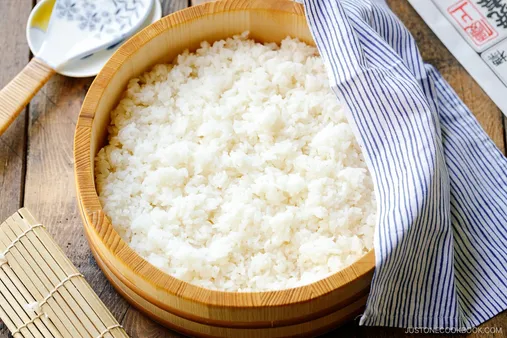Table of Contents
Welcome to the ultimate guide on How to make authentic Japanese sushi at home. Whether you're a seasoned sushi enthusiast or a curious beginner, Tauhuichiban has curated this comprehensive guide to empower you with the knowledge and techniques to create exquisite sushi rolls and other traditional delights. From selecting the finest ingredients to perfecting your presentation, we'll guide you through every step to ensure your sushi-making experience is not only successful but also authentic.

How to Make Authentic Japanese Sushi: A Comprehensive Guide
I. Preparing the Sushi Rice: The Heart of the Dish
Preparing the sushi rice is a crucial step in making authentic Japanese sushi. The rice is the foundation of the dish, providing the perfect base for the delicate flavors of the fish and other toppings. To achieve the ideal texture and flavor, it's essential to follow the traditional techniques and use high-quality ingredients.
The first step is to rinse the rice thoroughly to remove any impurities or starch. This helps to create a light and fluffy texture. Next, the rice is cooked in a specific ratio of water to rice, typically 1:1.25. The cooking process should be carefully controlled to prevent the rice from becoming overcooked or undercooked.
Ingredient | Quantity |
|---|---|
Sushi rice | 2 cups |
Water | 2.5 cups |
Rice vinegar | 1/4 cup |
Sugar | 2 tablespoons |
Salt | 1 teaspoon |
Once the rice is cooked, it's seasoned with a mixture of rice vinegar, sugar, and salt. This seasoning process, known as "sushi-zu," enhances the flavor and texture of the rice. The seasoned rice is then left to cool slightly before it's ready to be used for making sushi.
Preparing the sushi rice requires patience and attention to detail. By following the traditional techniques and using high-quality ingredients, you can create the perfect foundation for your authentic Japanese sushi.
Here are some additional tips for preparing sushi rice:
- Use a heavy-bottomed pot to cook the rice evenly.
- Do not stir the rice while it's cooking.
- Let the rice cool slightly before seasoning it.
- Use a wooden spoon or spatula to mix the seasoning into the rice.
- Store the sushi rice in the refrigerator for up to 24 hours.
With these tips, you can prepare delicious and authentic sushi rice that will impress your family and friends.

Preparing the Sushi Rice
II. Selecting and Preparing the Fish
When selecting fish for authentic Japanese sushi, freshness is paramount. Look for fish that has a firm texture, clear eyes, and bright red gills. Avoid fish that has a slimy or dull appearance.
Once you have selected your fish, it is important to prepare it properly. First, remove the scales and fins. Then, use a sharp knife to fillet the fish, removing the bones and skin. Finally, cut the fish into thin slices.
Type of Fish | Best for Sushi |
|---|---|
Tuna | Yes |
Salmon | Yes |
Yellowtail | Yes |
Eel | Yes |
Shrimp | Yes |

Selecting and Preparing the Fish
III. Assembling the Sushi
Once the sushi rice and the other ingredients are ready, it's time to assemble the sushi. This can be a delicate process, but with a little practice, you'll become a pro.
Tools you'll need: |
|---|
- Lay out a sheet of nori on the bamboo rolling mat. Wet your hands to prevent the rice from sticking to them.
- Spread a thin layer of rice over the nori, leaving about an inch of space at the top. Press the rice down gently to evenly distribute it.
- Arrange your desired fillings in the center of the rice. Be sure to leave some space at the bottom so that you can seal the sushi roll.
- Roll the sushi mat tightly from the bottom up. Use even pressure to ensure that the roll is tight and compact.
- Wet the knife with cold water and slice the sushi into 1-inch pieces. Serve immediately.
Here are some tips for assembling sushi:
- Use a sharp knife to cut the sushi. A dull knife will tear the sushi and make it difficult to eat.
- Wet the knife with cold water before each cut. This will help to prevent the sushi from sticking to the knife.
- Cut the sushi into even pieces. This will make it easier to eat and will also make it look more professional.
- Serve the sushi immediately. Sushi is best when it is fresh. If you need to store the sushi, wrap it in plastic wrap and refrigerate for up to 24 hours.
With a little practice, you'll be able to assemble sushi like a pro. So what are you waiting for? Give it a try!

Assembling the Sushi
IV. Garnishing and Serving the Sushi
Arrange the sushi pieces on a serving plate. You can use a variety of colors and shapes to create a visually appealing dish. For example, you could alternate between white fish, red fish, and green vegetables. You could also use different shapes, such as rolls, nigiri, and sashimi.
[Check out our related article on The Art and Science of Making Sushi Rice.]
Color | Shape |
|---|---|
White | Rolls |
Red | Nigiri |
Green | Sashimi |
Garnish the sushi with additional ingredients, such as shredded daikon radish, pickled ginger, or wasabi. You can also drizzle the sushi with soy sauce or ponzu sauce.
[Check out our related article on The Essential Ingredients and Tools You Need for Sushi Making.]
- Shredded daikon radish
- Pickled ginger
- Wasabi
- Soy sauce
- Ponzu sauce

Garnishing and Serving the Sushi
V. Conclusion
Mastering the art of authentic Japanese sushi requires patience, practice, and an appreciation for the culinary traditions of Japan. Embarking on this culinary journey is not only a rewarding experience but also a testament to your dedication and passion for food. By following the detailed instructions and tips outlined in this guide, you will be well-equipped to create exceptional sushi rolls and other traditional delights that will impress your family and friends. Remember, the pursuit of culinary excellence is an ongoing journey, and the joy of sushi-making lies in the continuous learning and refinement of your skills. With each delectable creation, you will not only nourish your body but also enrich your life with a profound appreciation for the art of Japanese cuisine.